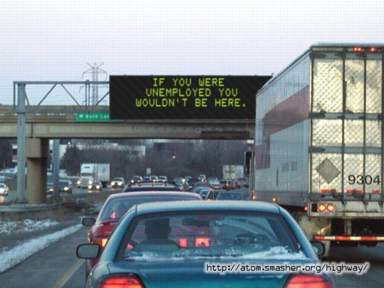 |
This week saw more than the usual number of goofy interpretations of dubious government data. Today we are treated to bad but better than expected payroll employment numbers. President Bush expressed hope today that economic-stimulus rebates beginning to reach taxpayers this week will help the economy. "This economy is going to come on. I'm confident it will," Bush said while visiting a technology plant in a St. Louis suburb, reported the Associated Press. We are reminded of similarly optimistic pronouncements in previous post-bubble periods. "I am convinced that through these measures we have reestablished confidence," said Herbert Hoover, December 1929. "The spring of 1930 marks the end of a period of grave concern... American business is steadily coming back to a normal level of prosperity," reported Julius Barnes, head of Hoover's National Business Survey Conference, March 16, 1930. It's only natural to see the data in the best possible light, especially in an election year.
Employers cut fewer jobs in April, jobless rate falls
Employers cut fewer jobs in April, jobless rate falls to 5 percent
May 2, 2008 (AP)
WASHINGTON (AP) -- Employers cut far fewer jobs in April than in recent months and the unemployment rate dropped to 5 percent, a better-than-expected showing that nonetheless reveals strains in the nation's labor market.
For the fourth month in a row, the economy lost jobs, the Labor Department reported Friday. But in April the losses totaled 20,000, an improvement from the 81,000 reductions in payrolls logged in March. Job losses for both February and March turned out to be a bit deeper than previously reported.
The latest snapshot of the nationwide employment conditions -- while clearly still weak -- was better than many economists were anticipating. They were bracing for job cuts of 75,000 and for the unemployment rate to climb to 5.2 percent.
AntiSpin: Bush's record for economic prognostications, equal to his talent for calling the ends of major combat operations, makes him too easy a target. CNN reported, "It's not good news, but it's not as bad as we thought it would be," said David Wyss, chief economist for Standard & Poor's. "It's consistant with the view it's going to be a mild recession, but an extended one, where you spend a lot of time bouncing around the bottom."
We see nothing to indicate that anything like a "bottom" in the economy has been reached. Typically, payroll employment dives through a recession and does not "bump along the bottom" until well after the recession is over. Here are the payroll data going back to 1969 charted as of today. The black line is payroll employment while the red line shows year over year change.
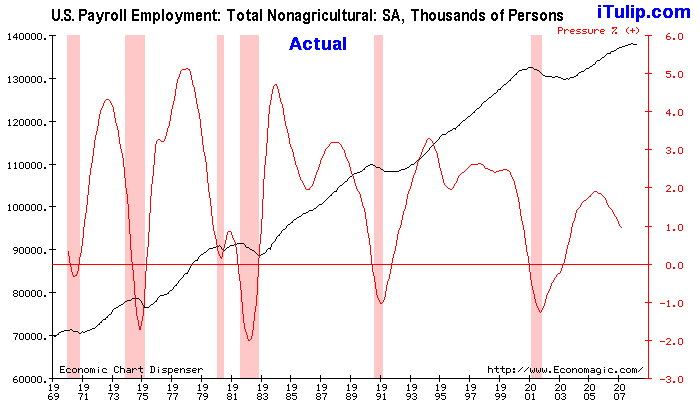
Job losses were concentrated in the usual areas: construction companies slashed 61,000 positions in April while manufacturers cut 46,000 and retailers cut 27,000.
Job gains came, in a trend that started years ago, in leisure and hospitality as hotels swell with Europeans and Asians visiting the US to spend their euros, yen, and yuan on goods at fire sale prices and stay at US hotels for 50 cents on the euro. More jobs were created in education as discouraged workers duck recession by the tried and true method of going back to school. This improves the unemployment statistics which stop counting them as "unemployed" after they give up. Aging baby boomers created more demand for health care, swelling payrolls at health care facilities. Together, health care and education added 56,000 jobs.
Gains again occurred again in the public sector, with government adding more than 9,000 jobs. Professional and business services companies added the most jobs. Not surprisingly, this category has the highest proportion of self-employed of all sectors. How many of your unemployed friends are "consulting"?
Average weekly earnings were off by $1.45 as employers cut wages in response to higher costs, and employees, with a lot of debt and fewer jobs options, are in no position to fight the cuts.
The big job loss areas are those hardest hit by the housing and credit debacles, especially California. The map below shows in dark blue Metropolitan Statistical Areas that have official unemployment rates above 10%, per the Bureau of Labored Statistics.
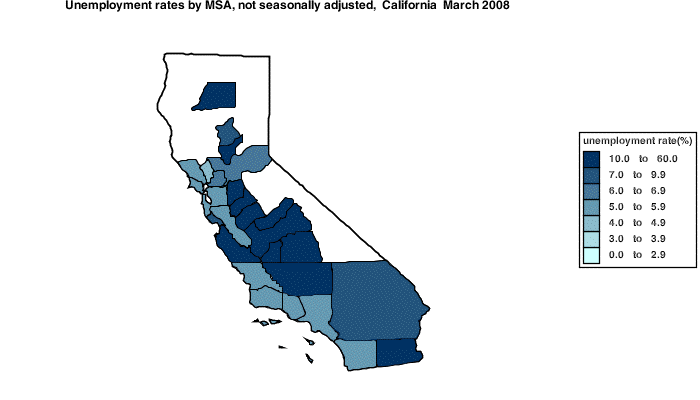
Our forecast projects payroll employment to decline by more than 90,000 in May.
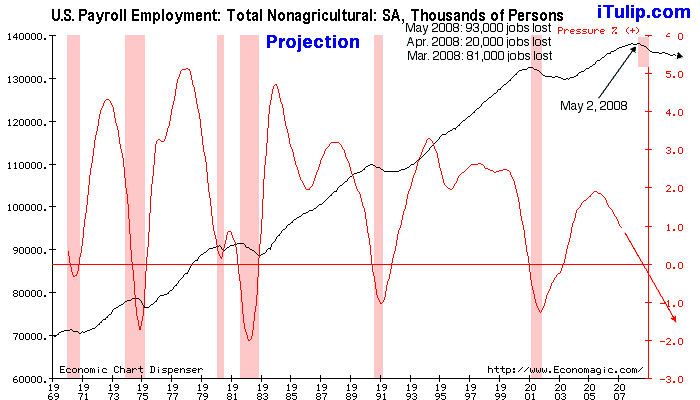
Once the Q1 2006 GDP numbers are revised down to show negative real growth for the quarter, it will be more apparent that we are at the beginning of the down trend in payroll employment. Payroll employment will decline for the next several quarters while the year over year fall in employment will reach -1% before turning up.
A mid-cycle bounce that you see slightly in 1976 and more pronounced in 1986 and 1996 might occur again in 2008 if similarly extreme government stimulus measures that were taken to create them are taken again and if they are effective without worsening inflation. In any case we should know by June whether a bounce is going to occur before payroll employment heads down into heavy negative territory.
iTulip Select: The Investment Thesis for the Next Cycle™
__________________________________________________
To receive the iTulip Newsletter or iTulip Alerts, Join our FREE Email Mailing List
Copyright © iTulip, Inc. 1998 - 2007 All Rights Reserved
All information provided "as is" for informational purposes only, not intended for trading purposes or advice. Nothing appearing on this website should be considered a recommendation to buy or to sell any security or related financial instrument. iTulip, Inc. is not liable for any informational errors, incompleteness, or delays, or for any actions taken in reliance on information contained herein. Full Disclaimer
A mid-cycle bounce that you see slightly in 1976 and more pronounced in 1986 and 1996 might occur again in 2008 if similarly extreme government stimulus measures that were taken to create them are taken again and if they are effective without worsening inflation. In any case we should know by June whether a bounce is going to occur before payroll employment heads down into heavy negative territory.
iTulip Select: The Investment Thesis for the Next Cycle™
__________________________________________________
To receive the iTulip Newsletter or iTulip Alerts, Join our FREE Email Mailing List
Copyright © iTulip, Inc. 1998 - 2007 All Rights Reserved
All information provided "as is" for informational purposes only, not intended for trading purposes or advice. Nothing appearing on this website should be considered a recommendation to buy or to sell any security or related financial instrument. iTulip, Inc. is not liable for any informational errors, incompleteness, or delays, or for any actions taken in reliance on information contained herein. Full Disclaimer
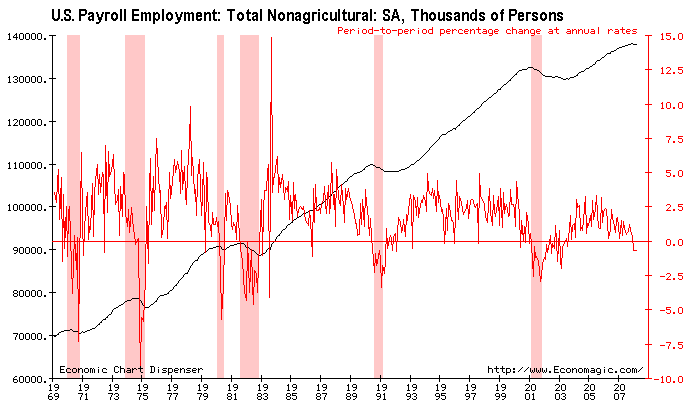
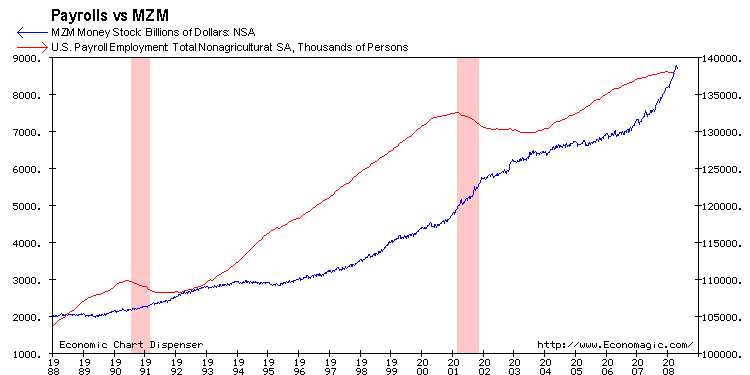


Comment